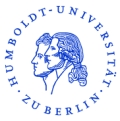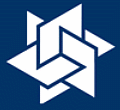
|

|

|
|
Humboldt-Universität zu Berlin |
DFG Research Center MATHEON |
Deutsches Zentrum für Luft- und Raumfahrt |

|

|

|
|
Humboldt-Universität zu Berlin |
DFG Research Center MATHEON |
Deutsches Zentrum für Luft- und Raumfahrt |
Norbert Kroll, DLR Braunschweig ( 9:00-9:40 )
Flow Simulation and Shape Optimization for Aircraft Design
Aerospace industry is increasingly relying on advanced numerical flow simulation tools in the early aircraft design phase. Today's flow solvers based on the solution of the Euler and Navier-Stokes equations are able to predict aerodynamic behaviour of aircraft components under different flow conditions quite well.
The presentation will highlight the major elements of the DLR flow solver software MEGAFLOW and will demonstrate its capability to predict viscous flows around complex industrial applications.
Due to the high computational expense required for flow simulations around realistic 3D configurations, in industry computational fluid dynamics tools are rather used for analysis and assessment of given geometries than for shape design and optimization. However, within the next few years numerical shape optimization will play a strategic role for future aircraft design. It offers the possibility of designing or improving aircraft components with respect to a pre-specified figure of merit subject to geometrical and physical constraints. Consequently, within the national project MEGADESIGN recently large research effort is devoted to develop efficient optimization strategies for industrial aerodynamic aircraft design.
Next to efficient and accurate flow solvers there are many ingredients required to establish an efficient and flexible numerical optimization capability. These include suitable techniques for geometry parametrization based on CAD data, meshing and mesh movement methods as well as a flexible tool-set of containing both deterministic and non-deterministic optimization strategies.
Download talk (PDF)
Nicolas Gauger, HU Berlin und DLR Braunschweig ( 9:40-10:20 )
Efficient Aerodynamic Shape Designs by Adjoint Approaches
As already motivated in the talk of Mr.Kroll, adjoint flow solvers are one of the components required in order to establish an efficient numerical optimization capability for aerodynamic shape designs. The development of adjoint flow solvers (integrated in the MEGAFLOW software system) and their application to shape designs of airfoils and 3D aircraft configurations are presented. Furthermore, it will be demonstrated that the adjoint approaches can handle multi-point designs, multi-constraints as well as multi-disciplinary optimization (MDO) problems.
Download talk (PDF)
Werner Haase, EADS Military Aircraft, München ( 10:40-11:20 )
Industrial Requirements for Aircraft Design
The presentation is based on results obtained from several projects on shape and performance optimisation. It will provide an insight in the use of evolutionary algorithms (GA and ES) and will describe the industrial needs.
In turn, results will be provided which will justify the use of evolutionary algorithms on one hand and on the other hand will explain the deficiencies that still exist in industrial environment when aiming at optimisation in general. In particular when Pareto optima are concerned the questions of parameterisation and proper use of analysis tools have to be answered adequately. Thus, emphasis will be placed on presenting advantages and disadvantages in the optimisation processes, i.e. how to set them up, how to use an efficient parameterisation, how to adopt a CFD method which accurately reflects the physical properties, and what meshes to use.
Results will be presented for inverse airfoil single- and multi-point design as well as additional results for a three-point optimisation of the RAE2822 airfoil. The latter case incorporates an objective function aiming at reducing drag in the specified three design points handling a set of pre-defined physical and geometrical constraints. Moreover, results for 3D wing design using CATIA-v5 as a parameterisation tool will be presented as well as a multidisciplinary (aeroelastic) wing optimisation. Concerning three-dimensional applications, results will be discussed that have been obtained for a wing planform optimisation of the X31 aircraft.
Download talk (PDF)
Suresh Deshpande, Jawaharlal Nehru Center for Advanced Scientific Research, Bangalore, India
G.N.Shashi Kumar, and A.K.Mahendra, Machine Dynamics Division, BARC, Mumbai, India ( 11:20-12:00 )
Shape Optimisation using Grid Free Solver and Evolutionary Algorithm
Grid free solvers are very attractive numerical methods of obtaining solution of PDE of fluid dynamics. The kinetic grid free solver called LSKUM (Least Square Kinetic Upwind Method) has been very successfully applied to a large number of practical flow problems [1], [2], [3] and [4]. LSKUM requires a cloud of points around a body (airfoil, wing, flight vehicle etc.) and connectivity N(Po) for each point Po in the cloud. The connectivity N(Po) is a set of neighbors of Po and is generally obtained by connectivity preprocessor. The cloud can be generated by using any method for example, structured grid generator leads to a simple cloud of points, several overlapping grids leads to a chimera cloud. The LSKUM operating on a cloud of points is a very powerful tool of obtaining numerical solution of inviscid [2] as well as viscous flows [4] for geometrically complex configurations. Combining LSKUM with an evolutionary algorithm (such as GA for example) is a very attractive possibility in aerodynamic shape optimization. Sashi Kumar, Mahendra and Deshpande [5] were the first to apply LSKUM to a shape optimization problem.
Click here for full extendend abstract
Download talk (PDF)
Jens-Dominik Müller, Queen's University of Belfast ( 13:00-13:40 )
Performance and Application of Discrete Adjoint CFD Codes using Automatic Differentiation
Adjoint methods are a computationally inexpensive way of
deriving sensitivity information where there are fewer
dependent (cost) variables than there are independent
(input) variables. Automatic Differentiation (AD) software
makes it possible to create discrete adjoint codes with
minimal human effort and provides rigorous methods to
verify the correctness of the derived adjoint code.
In the first part we review the implementation of AD on
Fortran CFD codes. The structure of the underlying code is
critical to the performance of the transformed code. We give
details on how small rearrangements in the primal CFD code
can be used to produce competitive tangent and adjoint code
using AD.
In the second part we outline how to incorporate AD-derived
code into optimal design loops. We will discuss difficulties
arising in satisfying constraints and we will discuss
using adjoints in multi-level one-shot design optimisation.
Download talk (PDF)
Volker Schulz, University Trier ( 13:40-14:20 )
Simultaneous Pseudo-Timestepping Methods for Aerodynamic Shape Optimization
Flow solvers for aerodynamic flow computations are often
based on the pseudo-timestepping concept. Efficient
algorithms for shape optimization based on these solvers
have to take this structural information into acount.
In this talk, new simultaneous pseudo-timestepping approaches for
shape optimization are discussed and numerical results for
realistic 2D and 3D problem configurations are presented.
Download talk (PDF)
Andreas Griewank, Nicolas Gauger, Jan Riehme, HU Berlin ( 14:20-15:00 )
Definition and Evaluation of projected Hessians for Piggyback Optimization
In piggyback optimization we attempt to turn a given iterative state equation
solver into an optimization algorithm. Adjoining the solver yields approximate
reduced gradients, which must be preconditioned and scaled to yield reasonable
correction steps on the optimization variables. For that purpose we examine
various projected Hessian matrices with respect to the resulting overall
convergence speed and discuss their evaluation or approximation based on second
order adjoint evaluations.
Download talk (PDF)
Per Weinerfelt , Saab Aerosystems, Linköping ( 15:20-16:00 )
Optimzation using Adjoint Technique Applied to Problems in Aerodynamics, Electromagnetics and Bio Fluid Mechanics
The talk will focus on optimization problems where the governing equations
are PDEs: For efficient calculations of optimal solutions adjoint equations,
derived from the PDE's, are used. Formulation of the optimization problem, the
adjoint equations and computational results will be presented. The results are
taken from three different applications, Aerodynamics, Electromagnetics and Bio Fluid Mechanics.
Download talk (PDF)
Thomas Slawig, TU Berlin ( 16:00-16:40 )
Analytic Representations for Gradients in Shape Optimization
From the mathematical point of view an analytic representation for the
gradient in shape optimization problems is a very interesting and
challenging task.
We present some results in this area that might be used for problems in
fluid mechanics.
The aim of the talk is to discuss the applicability of these approaches and
results for real-world problems.
Download talk (PDF)
Xiaofan Yang, KTH Stockholm ( 16:40-17:20 )
Turbulence Modeling of Separation Control by means of Vortex Generators
A model for an array of vortex generators is implemented into a
Reynolds Average Navier-Stokes (RANS) computing code with a
differential Reynolds stress turbulence closure. The increased mixing
caused by vortex generators in a real flow is in the model realized by
increasing the wall-normal and spanwise velocity fluctuations
according to distributions given by a Lamb-Oseen vortex model. The
circulation and vorticity of the Lamb-Oseen vortices are estimated
using wing theory and the local flow at the position of the vortex
generators. The model is tested in a plane asymmetric diffuser
geometry. By adjusting several parameters of the vortex generators
good results of the separation control are obtained and their
influences to the flow field are known.
Download talk (PDF)